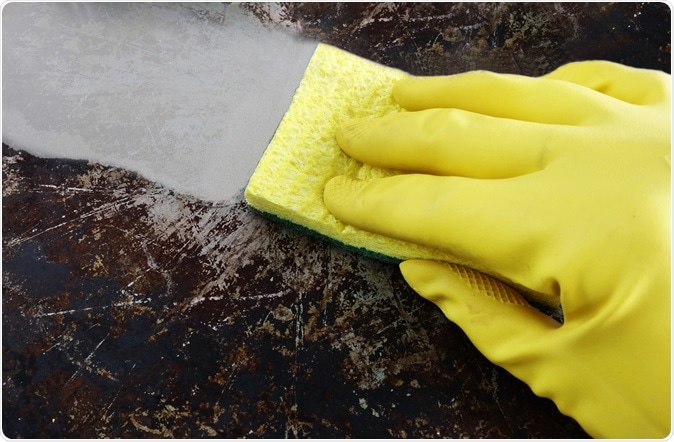Scientists in Germany have looked into the minute pores of a common kitchen sponge and found dreaded bacteria that could make us very ill. This is the first comprehensive study to do so. The study was published this week in Scientific Reports. Researchers write that humans spend most of their time in built environments or BE and the microbial presence in these environments is termed BE microbiome. These microbes may have a great impact on human health and wellbeing.

Image Credit: Zimmytws / Shutterstock
Research team from Furtwangen University performed a detailed genetic analysis using by high–throughput 16S rRNA gene sequencing from samples obtained from 14 used kitchen sponges, collected from households in south-western Germany. They found a mind-boggling 362 different types of living bacteria residing in the foam. While most of the bacterial species were deemed harmless some of them were indeed harmful. Lead researcher, microbiologist Markus Egert explained that of the ten types of commonly found bacteria in the samples, five were classified as “risk group 2 or RG2” meaning that they could become potential pathogens or infective organisms for humans. These included Acinetobacter johnsonii, Moraxella osloensis, Chryseobacterium hominis, Acinetobacter pittii and Acinetobacter ursingii. Moraxella species of bacteria have been reported to be found in sponges and loofahs in earlier studies. These bacteria tend to come from humans as they are normal colonizers on human skin. The distribution of bacterial phyla was as follows;
- Proteobacteria 68.51% per sample
- Bacteroidetes (26.35%)
- Actinobacteria (3.69%)
- WPS-2(<1%)
- Firmicutes (<1%)
- Planctomycetes (<1%)
- Saccharibacteria (<1%)
- Verrucomicrobia (<1%)
- Chloroflexi (<1%)
According to class of bacteria Gammaproteobatceria was found most abundantly (51.14%) followed by Pseudomonadales and Flavobacteriales at 45.64% and 23.21%, respectively. Among bacterial families Moraxellaceae and Pseudomonadaceae at 36.04% and 9.58%, respectively and Flavobacteriales at 21.9% were most abundant. Dreaded pathogens like Staphylococcus, Streptococcus, Salmonella, Proteus and Campylobacter were found relatively in very low concentrations.
The research team have written that the kitchen sponges thus are the “biggest reservoirs of active bacteria in the whole house”. The porous structure of these sponges make them breeding grounds for the microbes. As we use these sponges to rub other clean surfaces such as utensils, appliances, kitchen sinks and bench tops, they spread and disseminate these growing bacteria. Researchers have thus called these sponges not only “reservoirs” or “microbial incubators” of the microbes but also “disseminators” of these germs that can be the main reason for spread of the infection and also contamination of hands and food. They may be linked to “food-borne disease outbreaks”.
For this study the team looked at the sponge samples in microscopic 3D images using a technique called fluorescence in situ hybridisation along with confocal laser scanning microscopy (FISH–CLSM). Microscopy clearly showed residual food matter in the sponges and the moistness of the foams provide a perfect place where the bacteria can grow and multiply. According to Egert, in occasional samples the bacterial concentration have been found to be five times 1010 cells per cubic centimetre which is quite dense and same as in fecal or stool samples. He added that these concentrations should never be found in and around the kitchen. It must be noted that unused sponges, although not sterilized, did not contain the bacterial load.
Common solution to this problem would be to clean the sponges by putting them in boiling water or microwaving them. Egert urged people not to do that. These steps, he explained would only strengthen the germs. Also in their study they note that cleaned and uncleaned sponges have similar bacterial loads. In cleaned ones there may be a rise in Moraxella and Chryseobacterium concentration added the researchers. They write that most bacteria take up the cleaning challenge and re grow with more speed to achieve similar concentrations as before. These findings resemble the effects of antibiotics on the harmless bacteria that live in the gut. The best option is to replace them every week they add.
References